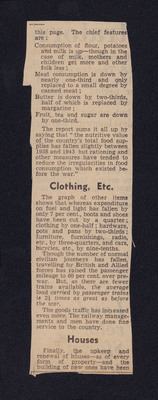Statistics food, clothing and houses
Title
Statistics food, clothing and houses
Description
Mentions consumption of various foodstuffs. Mentions expenditure on boots, shoes, clothing, hardware, furnishings , radios and other items. Covers travel and goods transport.
Spatial Coverage
Coverage
Language
Type
Format
One newspaper cutting
Publisher
Rights
This content is available under a CC BY-NC 4.0 International license (Creative Commons Attribution-NonCommercial 4.0). It has been published ‘as is’ and may contain inaccuracies or culturally inappropriate references that do not necessarily reflect the official policy or position of the University of Lincoln or the International Bomber Command Centre. For more information, visit https://creativecommons.org/licenses/by-nc/4.0/ and https://ibccdigitalarchive.lincoln.ac.uk/omeka/legal.
Identifier
SValentineJRM1251404v10105
Transcription
this page. The chief features are:
Consumption of flour, potatoes and milk is up – though in the case of milk, mothers and children get more and other folk less;
Meat consumption is down by nearly one-third and only replaced to a small degree by canned meat;
Butter is down by two-thirds, half of which is replaced by margarine;
Fruit, tea and sugar are down by one-third.
The report sums it all up by saying that “the nutritive value of the country’s total food supplies has fallen slightly between 1938 and 1943 but rationing and other measures have tended to reduce the irregularities in food consumption which existed before the war.”
Clothing, Etc.
The graph of other items shows that whereas expenditure on fuel and light has fallen by only 7 per cent., boots and shoes have been cut by a quarter; clothing by one-half; hardware, pots and pans by two-thirds; furniture, furnishings, radio, etc., by three-quarters, and cars, bicycles, etc., by nine-tenths.
Though the number of normal civilian journeys has fallen, travelling by British and Allied forces has raised the passenger mileage to 60 per cent. over pre-war. But, as there are fewer trains available, [italics] the average load carried by passenger trains is 2 1/4 times as great as before the war. [/italics]
The goods traffic has increased even more. The railway managements and men have done fine service to the country.
Houses
Finally, the upkeep and renewal of houses – as of every form of property – and the building of new ones have been
Consumption of flour, potatoes and milk is up – though in the case of milk, mothers and children get more and other folk less;
Meat consumption is down by nearly one-third and only replaced to a small degree by canned meat;
Butter is down by two-thirds, half of which is replaced by margarine;
Fruit, tea and sugar are down by one-third.
The report sums it all up by saying that “the nutritive value of the country’s total food supplies has fallen slightly between 1938 and 1943 but rationing and other measures have tended to reduce the irregularities in food consumption which existed before the war.”
Clothing, Etc.
The graph of other items shows that whereas expenditure on fuel and light has fallen by only 7 per cent., boots and shoes have been cut by a quarter; clothing by one-half; hardware, pots and pans by two-thirds; furniture, furnishings, radio, etc., by three-quarters, and cars, bicycles, etc., by nine-tenths.
Though the number of normal civilian journeys has fallen, travelling by British and Allied forces has raised the passenger mileage to 60 per cent. over pre-war. But, as there are fewer trains available, [italics] the average load carried by passenger trains is 2 1/4 times as great as before the war. [/italics]
The goods traffic has increased even more. The railway managements and men have done fine service to the country.
Houses
Finally, the upkeep and renewal of houses – as of every form of property – and the building of new ones have been
Citation
“Statistics food, clothing and houses,” IBCC Digital Archive, accessed November 5, 2024, https://ibccdigitalarchive.lincoln.ac.uk/omeka/collections/document/22089.
Item Relations
This item has no relations.

